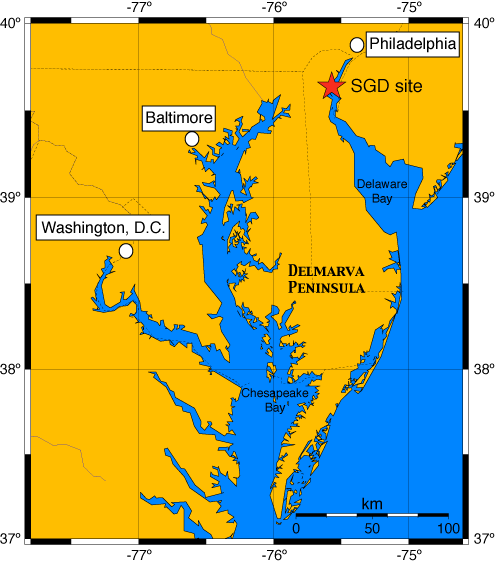Delmarva Peninsula
THE 5,940-square-mi (15,384 square km) Delmarva Peninsula is located in the mid-Atlantic area of the UNITED STATES and borders the Chesapeake Bay, the Delaware Bay and the ATLANTIC OCEAN. The historic importance of the area is that it formed an important political and social demarcation between the North and the South of the United States: the Mason Dixon Line.
The border between MARYLAND and DELAWARE formed the initial portion of the Mason-Dixon line, drawn in the mid-1700s to settle a boundary dispute between the Calvert family and the Penn family. The Mason-Dixon line later became the delineation between northern states and southern states, and therefore between slave states and free states. The name Delmarva comes from letters in the state names that share it, including all of DELaware, and portions of MARyland, and VirginiA.

Compared to the rest of the United States, the Delmarva Peninsula is strikingly flat, with most of the area approximately 30 ft (9 km) above sea level. Interestingly, this area was not always flat. Two hundred million years ago, the APPALACHIAN MOUNTAINS were the edge of the ocean. The shoreline itself then was rocky, resembling a steeper version of the current coast of MAINE. The long, flat, sandy beaches that characterize today's Delmarva coastline emerged because of continental drift. The Appalachians have been moving westward for 245 million years, and they've been doing it at a yearly rate that just about equals the speed at which fingernails grow. As the Appalachians were drifting westward, they also eroded. Their rocks were weathered into sand. This sand was carried by streams and rivers to the coast and deposited. Over time, these deposits, once under water, have been exposed and now form the coastal beaches.
CHANGING GEOGRAPHY
Today, coastal currents and storms are changing the geography again. This can be seen even in maps of the area between the coastal towns of Rehoboth and Cape Henlopen. These show that since 1878, the shoreline has moved almost 1,200 ft (366 m) inland. The wide sandy beaches of Delmarva are a major tourist destination and a major economic resource for the area. Maryland's heavily developed Ocean City has a yearround population of less than 10,000, but during peak summer weekends, the population swells to more than 300,000.
With a shallow and changing coastline and a lack of natural harbors and energy resources, Delmarva did not become heavily industrialized as did some of its neighboring areas. Today, intensive truck gardening agriculture, poultry farming, and the seafood industries form the backbone of the peninsula's economy. Its strategic location, just a few hours from Baltimore, Washington, D.C., and Philadelphia, with overnight access to almost one-third of the nation's population, have made it a major food supplier for the East Coast of the United States.